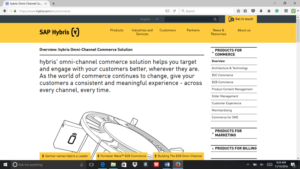The shopping environment of previous generations has been replaced with robust virtual shopping experiences, one-click ordering, and apps that serve up lightning-fast and highly relevant user experiences. This progression has fueled shifts in buyer behavior and an evolution in the best e-commerce platforms.
Today, buyers expect brands to deliver more. And e-commerce companies have to work harder than ever to meet those demands, but the payoff is worth it.
By 2018, it’s expected that online sales in the U.S. will grow to $414 billion, a 57 percent increase over just three years ago. And by the year 2020, customer experience is expected to overtake price and product as the key brand differentiator.
The capabilities of your e-commerce platform affect your ability to engage customers more deeply and create a truly extraordinary buyer experience. Some retailers find that the right e-commerce technology partner can help them overcome the limitations of their platform. Other retailers find the need to switch to an e-commerce platform that can meet their growing needs.
If you’re in the market for a new e-commerce platform, where should you start? Here are nine factors to consider before adopting a new e-commerce platform.
Reporting and Analytics: View Customers with Clarity
Today there is no shortage of available data. Transforming that data into valuable insights is where most companies get stuck. Max Levchin, PayPal co-founder, said, “The world is now awash in data and we can see consumers in a lot clearer ways.”
But insight is not enough. You must have the right tools to turn insights into action.
Here are a few questions to consider as you evaluate the reporting and analytical capabilities of a new e-commerce platform.
- Does this platform allow you access to historical and behavioral data? If so, how can you transform that data into actionable insights to fuel more authentic and engaging customer experiences?
- What specific insights can you learn from the searches that your customers are conducting through the platform?
- What types of data-rich tools does this platform offer? Does it provide reports, dashboards or other resources that can drive greater performance?
- Will this platform help you monitor key business metrics, for example, conversation rates or average order values?
Your goal is to create the experiences that your customers demand. Be sure your e-commerce platform offers the analytics to get you there.
Integration: Does It Play Nicely With Others?
A major factor that sets e-commerce platforms apart is third-party integration. Most companies are using a variety of third-party applications in their daily workflow, so it’s critical to select a solution that will seamlessly integrate with your existing applications.
For example, maybe you use an application that targets customers by geographic location. Or perhaps you leverage an application that helps to discover customer shopping habits and generates personalized emails based on those behaviors. Here are a few questions to ask to ensure your new e-commerce platform supports the third-party functionality you need.
- Where is customer data stored in the e-commerce platform, and can that data be harnessed by third-party applications?
- Which application owns pricing? Can it integrate with other applications?
- How are credit card details authorized and fraud detection handled?
- Can existing and future promotions be synchronized with other channels, creating a consistent omni-channel experience for customers?
Depending on the complexity of your existing environment, integration may be a key factor for your business. Before you buy, get an in-depth understanding of how existing applications and applications you may need in the future will integrate into the platform.
Scalability: Find a Partner That Can Grow With You
The word “scalability” is used all the time when it comes to technology. But in the case of selecting an e-commerce platform, it’s especially important. Why?
E-commerce is growing, which means in five years your business needs may look much different. Switching platforms is a large undertaking, which requires internal resources, time and money. Considering scalability today will save time and headaches in the future. Here are a few questions to consider.
- How many visitors does this solution currently support?
- What is the average number of orders per hour, day and week this platform can support? How does this compare to your company’s current volume and future forecasts?
- Can this solution support a complex product catalog? How many SKUs can it support?
It’s tempting to purchase only what you need, especially if there are budget concerns. After all, some of the features won’t appear relevant to today’s business. But when you weigh today’s needs with future needs, you can strike a healthy balance that ensures future success.
Product Catalog: Display the Right Products at the Right Time
Your product catalog is at the core of your e-commerce business. You can’t afford to lose customers at this step in the buying cycle. So, when selecting a new platform, what should you think about in regard to your product catalog? Here are a few questions to consider.
- What types of products can the platform display? Can it display the products that you offer today as well as what you may offer in the future?
- Can you easily present related accessories and product bundles to clients? For example, if your customer is shopping for dresses, can you present matching sweaters, shoes and jewelry?
- Are there any limitations to the way this platform displays products? And if so, are those factors critical today or in the future?
Every customer will engage with your product catalog. It’s where they’ll decide whether to purchase from you or go elsewhere. The right platform helps you get this piece of the puzzle right and drives higher conversion rates.
Search Ability: Find, Seek … Delight
Nothing is worse for a customer than searching for a product – one that you offer – and coming up empty-handed. Customers’ attention spans are shorter than ever, so you must deliver what they want at the moment of relevance. Otherwise, they are lost forever.
Select an e-commerce platform with robust search capabilities that deliver without fail and support a dynamic search experience.
If you’ve located the perfect e-commerce platform, but the search functionality is lacking, don’t worry. This isn’t a huge problem – so long as the platform integrates well with leading search providers. Here are a couple questions to consider:
- What does the e-commerce search experience look like for this platform? Ask for a demo so you can better understand how it works and uncover any potential flaws and integration capabilities.
- How easy is it to integrate with leading search providers? Does the process feel intuitive to users?
For example, e-commerce platform Magento provides flexible integration with leading search providers, making it easy to offer users a more seamless e-commerce experience.

Another good example is SAP Hybris, which allows you to provide a consistent omni-channel experience for customers along with seamless search integration and capabilities.

Customers come to your e-commerce site with high expectations. When you deliver and exceed those expectations with the right e-commerce platform and robust search integration, you create strong relationships and increase customer loyalty.
Design Flexibility: Deliver an On-brand Experience
The majority of customers are visual. It’s how they learn, process information and prefer to engage with the world. In fact, 65 percent of people are visual learners. So what’s the connection between visual learners and your e-commerce business?
The answer is simple. You need to capture attention, hold on to it, and use it to generate interest. Flexibility in design makes this possible. The average e-commerce site’s bounce rate is 33.9 percent. That means that nearly a third of all people visiting an e-commerce site are leaving right away. Agile design helps you decrease bounce rates.
When looking for a new e-commerce platform, ensure that site navigation is easy, the page layout is intuitive, and the steps required to complete the shopping process are visually engaging. Here are a few questions to consider.
- What options are available for page layout?
- How flexible are the design options?
- Can you use an outside designer to create pages, and if so, does the platform make the process easy?
The right platform is all about simplicity, flexibility, and agility. You need it to be customer-friendly and simple for your internal team and outside partners to customize.
Site Security: Lock It Down, Protect Your Customers
Security is a key component when selecting the right e-commerce platform because it’s critical to the success of your business. You don’t need to look far to see what happens when security is weak. Target, Home Depot, and Anthem are prime examples.
In addition, those collecting customer payment information must also use a PCI-compliant processor. So the provider that you select should offer a platform that works easily and securely with your preferred payment processor.
Ask any potential partners about the security of their offerings and how they integrate with PCI-compliant processors.
Support and Service: More Than a Vendor, a Partner
With any new platform, even the most user-friendly, you will likely have questions. What will happen if your team gets stuck? If the answer includes being sent to voicemail or waiting on hold, you may want to keep looking.
Start by asking what resources are available online. Some providers offer how-to guides, FAQs or, even better, video tutorials for common problems. In other cases, online resources aren’t solving the problem and you need real-time assistance from a person. How hard is it to speak with someone? What are the average wait times?
Deploying a robust e-commerce system is great, but all the features aren’t worth it if you can’t get the help you need quickly. Support and service are key differentiators for e-commerce platform offerings, helping you to better serve customers and operate with greater efficiency.
Pricing and Budget… Never Sacrifice on Quality
We can’t talk about selecting the right e-commerce platform without addressing budget. Regardless of your company size, you likely have a limit to what you can spend. While cost is important, avoid making it the center of your search.
There are many costs to implementing a new e-commerce system that are not included in the initial price. For example, maybe the provider doesn’t offer great support, so employees are wasting countless hours troubleshooting problems – and even worse, the customer experience is suffering. You won’t see these costs in the price tag, but they’ll show up later as lost sales or diminished productivity.
If you purchase a platform based on price and then later discover that it’s missing critical features, expenses can add up fast when you’re forced to purchase new tools or modify existing tools to make it work.
Consider price, but don’t make it your focal point.
In the End … It’s all about the Customer
The best e-commerce platform is the one that helps you provide a stellar customer experience. It helps you exceed your customers’ expectations with shopping experiences that flow easily and naturally. Jeff Bezos, founder of Amazon, said, “A brand for a company is like a reputation for a person. You earn reputation by trying to do hard things well.”
When you select the right e-commerce platform for your business, you’re on your way to creating lasting relationships and loyal customers – the Holy Grail in a highly competitive marketplace.
What is SLI?
At SLI, our machine-learning platform offers up the most advanced technology available to accelerate your e-commerce and continuously delight customers at every click.
For more tips, check out our platform guide, SLI Advanced Technology and Infrastructure Overview.








